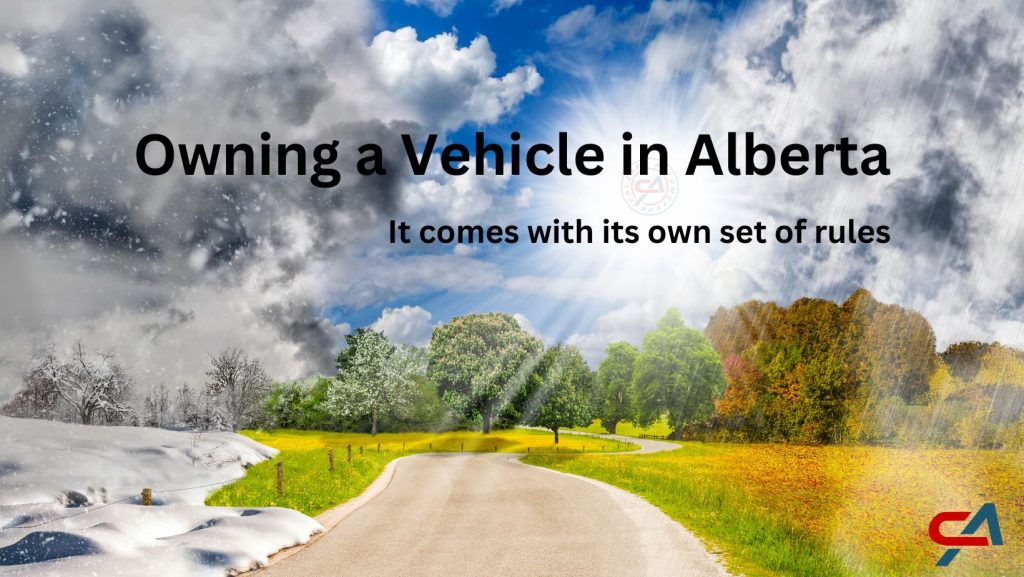Owning a vehicle in Alberta comes with its own set of considerations for maintenance, especially given the diverse weather conditions and potential wear and tear over the years. Here are some key aspects to consider during your vehicle ownership if you live here or plan on moving to Alberta:
Tire/Winter Tire Maintenance
In Alberta, winters can be harsh. Ensure your winter tires are in good condition with sufficient tread depth. Rotate them regularly and check for any signs of damage.
Tire/Winter Tire Neglect
Insufficient tread on tire/winter tires can result in poor traction and handling on icy or snowy roads, increasing the risk of collisions and reducing overall safety.
Battery Health
Cold temperatures can strain the battery. Test the battery’s voltage regularly, clean terminals, and consider replacing it if it’s showing signs of weakness.
Battery Negligence
A weakened battery in cold weather may lead to difficulty starting the vehicle, potential breakdowns, and the inconvenience of being stranded.
Fluid Checks in Cold Weather
Cold temperatures can affect fluids like oil, transmission fluid, and coolant. Ensure these are at proper levels, and consider using winter-grade oil.
Cold Weather Fluid Challenges
Inadequate essential fluids can compromise engine performance, potentially leading to overheating, transmission issues, and reduced overall reliability.
Corrosion Prevention
The undercarriage may be prone to rust in regions where road salt is used. Regularly wash your vehicle, including the undercarriage, and consider applying rustproofing if you still need to do so.
Corrosion Buildup
Neglecting to address rust on the undercarriage can lead to structural damage, compromising the integrity of the vehicle and potentially resulting in safety hazards.
Brake Inspection
Winter conditions can be harsh on brakes. Regularly inspect and service the braking system, including pads, rotors, and brake fluid.
Brake System Neglect
Failing to service brakes regularly may result in decreased stopping power, longer braking distances, and, in extreme cases, brake failure.
Cooling System Checks
Ensure the cooling system functions well, especially if you experience extreme temperature variations. Check the radiator, hoses, and thermostat.
Cooling System Failures
A malfunctioning cooling system can lead to engine overheating, potential damage, and costly repairs if not addressed promptly.
Timing Belt/Chain Inspection
If your vehicle has a timing belt, check if it’s due for replacement based on the manufacturer’s recommendations. If it has a timing chain, ensure it’s in good condition.
Timing Belt/Chain Issues
Ignoring the replacement interval for a timing belt may result in its failure, causing significant engine damage and costly repairs.
Electrical System Check
Inspect lights, signals, and other electrical components. Ensure they are working correctly, especially during the darker winter months.
Electrical System Failures
Malfunctions in lights and signals can compromise visibility, increasing the risk of accidents, and issues with other electrical components may lead to operational failures.
Suspension and Steering Components
Harsh road conditions and potholes can impact the suspension and steering. Regularly inspect these components for wear or damage.
Suspension and Steering Problems
Neglecting worn or damaged suspension and steering components can compromise vehicle stability, handling, and safety.
Exhaust System Inspection
Road salt and moisture can accelerate exhaust system corrosion. Check for rust, leaks, or unusual noises, and address any issues promptly.
Exhaust System Corrosion
Untreated rust in the exhaust system can lead to leaks, reduced fuel efficiency, and increased emissions, potentially causing environmental harm.
Transmission and Differential Service
Check your vehicle’s manual for recommended transmission and differential fluid change intervals. This is often overlooked but crucial for smooth operation.
Transmission and Differential Failures
Neglecting fluid changes in these systems can result in poor performance, increased wear, and eventual failure, leading to costly repairs.
Check for Recalls and Technical Service Bulletins (TSBs)
Periodically check for any recalls or TSBs related to your vehicle model. This ensures that any potential safety or performance issues are addressed.
Overlooking Recalls and TSBs
Ignoring recalls and TSBs may expose you to safety hazards or missed opportunities to address potential issues early, leading to more extensive and expensive problems.
Regular Cleaning
Regularly wash and wax your vehicle to protect the paint from harsh weather conditions, road salt, and contaminants.
Drive Belts and Hoses Inspection
Inspect the condition of drive belts and hoses, looking for signs of wear, cracks, or leaks.
Neglected Drive Belts and Hoses
Cracked or worn drive belts and hoses can result in engine overheating, loss of power steering, or even engine failure if not addressed promptly.
Documentation and Records
Keep a detailed record of all maintenance and repairs. This helps you track your vehicle’s history and can be valuable when selling or trading in the car.
Inadequate Documentation
Proper maintenance and repair records make tracking the vehicle’s history easier, potentially leading to decreased resale value and difficulties in diagnosing recurring issues.
Regular attention to these maintenance items will help ensure your vehicle remains reliable, safe, and performs well, even in the challenging Alberta climate. Regular inspections and prompt attention to any issues will contribute to your vehicle’s longevity and overall health. Addressing these maintenance considerations proactively is essential for sustaining your vehicle’s reliability, safety, and longevity in the province of Alberta environment. Neglecting these aspects may result in increased repair costs, decreased performance, and a higher likelihood of unexpected breakdowns.

